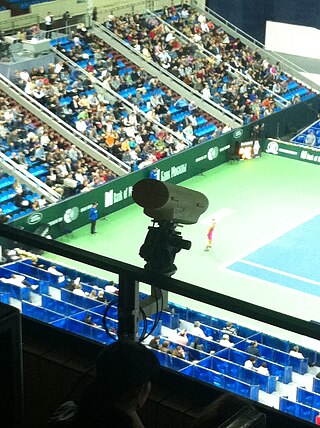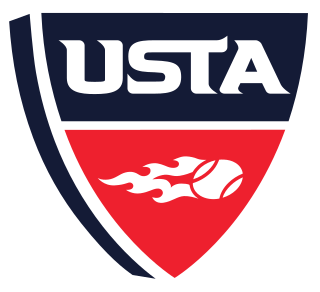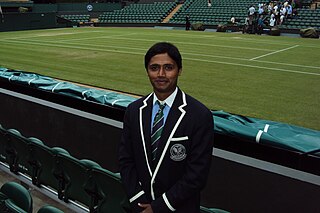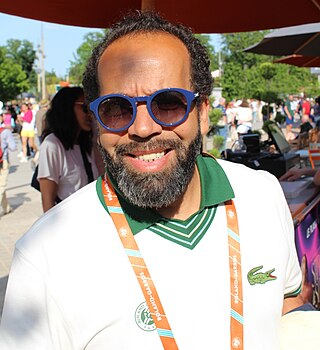
Tennis is a racket sport that is played either individually against a single opponent (singles) or between two teams of two players each (doubles). Each player uses a tennis racket that is strung with cord to strike a hollow rubber ball covered with felt over or around a net and into the opponent's court. The object of the game is to manoeuvre the ball in such a way that the opponent is not able to play a valid return. The player who is unable to return the ball validly will not gain a point, while the opposite player will.

A referee is an official, in a variety of sports and competition, responsible for enforcing the rules of the sport, including sportsmanship decisions such as ejection. The official tasked with this job may be known by a variety of other titles depending on the sport, including umpire, judge, arbiter (chess), commissaire, or technical official. Referees may be assisted by umpires, linesmen, timekeepers, touch judges, or video review officials.

Hawk-Eye is a computer vision system used in numerous sports such as cricket, tennis, Gaelic football, badminton, hurling, rugby union, association football and volleyball, to visually track the trajectory of the ball and display a profile of its statistically most likely path as a moving image. The onscreen representation of the trajectory results is called Shot Spot.

The United States Tennis Association (USTA) is the national governing body for tennis in the United States. A not-for-profit organization with more than 700,000 members, it invests 100% of its proceeds to promote and develop the growth of tennis, from the grass-roots to the professional levels. The association was created to standardize rules and regulations and to promote and develop the growth of tennis in the United States.

In gridiron football, an official is a person who has responsibility in enforcing the rules and maintaining the order of the game.
Instant replay or action replay is a video reproduction of something that recently occurred which was both shot and broadcast live.
Jeffrey Gail Tarango is a retired American tennis player. He was a top-ten doubles player and a runner-up at the 1999 French Open men's doubles tournament. He is now the Director of Tennis at the Jack Kramer Club, which is just south of Los Angeles. In 2018, he was the tournament director of a $30,000 men's California championships. At that championships, ATP world-ranked No. 11, Sam Querrey, beat Davis Cup captain Mardy Fish to win this event.
A point in tennis is the smallest subdivision of the match. A point can consist of a double fault by the server, in which case the point is automatically won by the receiver. In all other cases, a point begins when a legal serve is hit by the server to the receiver on the opposite side of the court, and continues until one side fails to legally return the ball to the opposite side. Whichever side fails to do so loses the point and their opponent wins it.
This page is a glossary of tennis terminology.

Ball badminton is a sport native to India. It is a racket sport game, played with a yellow ball made of wool, on a court of fixed dimensions divided by a net. The game was played as early as 1856 by the royal family in Tanjore, the capital of Thanjavur district in Tamil Nadu, India. It enjoys the greatest popularity in India. Ball badminton is a fast-paced game; it demands skill, quick reflexes, good judgment, agility, and the ability to control the ball with one's wrist.
An official in Canadian football is a person who has responsibility in enforcing the rules and maintaining the order of the game, like their counterparts in the American game. In the Canadian Football League, seven officials operate on the field. Lower levels of play up to the university level use less than the standard seven.

An electronic line judge is a device used in tennis to automatically detect where a ball has landed on the court. Attempts to revolutionize tennis officiating and the judging of calls in the sport began in the early 1970s and has resulted in the design, development and prototyping of several computerized, electronic line-judge devices. The methods have been based upon the use of pressure sensors, sensors to detect magnetized or electrically conductive tennis balls, infrared laser beams, and most recently video cameras.

Sagar Kashyap is a former under-18 tennis player from Mysore, Karnataka, India, and the youngest Indian to officiate at the Wimbledon Championship.

Adel Aref is a French-Tunisian former international tennis umpire and sports executive. He has also served as Director of Cabinet of the President at Paris Saint Germain Football Club and PR Director for BeIN Sports.
Chung Hyeon defeated Andrey Rublev in the final, 3–4(5–7), 4–3(7–2), 4–2, 4–2 to capture the 2017 Next Generation ATP Finals title.

Carlos Ramos is a retired Portuguese tennis umpire. Ramos, a gold badge chair umpire certified by the International Tennis Federation, is one of only two persons to have chair umpired a singles finals match in all four of the Grand Slam tournaments, the other being Alison Hughes. Ramos is also notable for umpiring many other high-profile matches and for penalizing several high-profile players during his decades-long career.

Kader Nouni is a French tennis umpire. He works primarily for the Women's Tennis Association (WTA) and has officiated six major finals. The International Tennis Federation (ITF) certified him as a gold badge umpire in 2007. Known for his baritone voice, Nouni is sometimes called the "Barry White of tennis".

Ali Nili is an Iranian-American tennis official who has a gold badge chair umpire certified by the International Tennis Federation.














